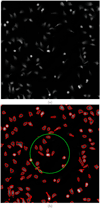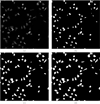Sub-population analysis based on temporal features of high content images
- PMID: 19958514
- PMCID: PMC2788355
- DOI: 10.1186/1471-2105-10-S15-S4
Sub-population analysis based on temporal features of high content images
Abstract
Background: High content screening techniques are increasingly used to understand the regulation and progression of cell motility. The demand of new platforms, coupled with availability of terabytes of data has challenged the traditional technique of identifying cell populations by manual methods and resulted in development of high-dimensional analytical methods.
Results: In this paper, we present sub-populations analysis of cells at the tissue level by using dynamic features of the cells. We used active contour without edges for segmentation of cells, which preserves the cell morphology, and autoregressive modeling to model cell trajectories. The sub-populations were obtained by clustering static, dynamic and a combination of both features. We were able to identify three unique sub-populations in combined clustering.
Conclusion: We report a novel method to identify sub-populations using kinetic features and demonstrate that these features improve sub-population analysis at the tissue level. These advances will facilitate the application of high content screening data analysis to new and complex biological problems.
Figures









References
-
- Singer S, Kupfer A. The directed migration of eukaryotic cells. Annu Rev Cell Biol. 1986;2:337–365. - PubMed
-
- Trinkaus T. Annual Reviews in Cell Biology. New Jersey, USA: Prentice Hall; 1984. Cells into Organs. The forces that shape the embryo.
Publication types
MeSH terms
LinkOut - more resources
Full Text Sources

